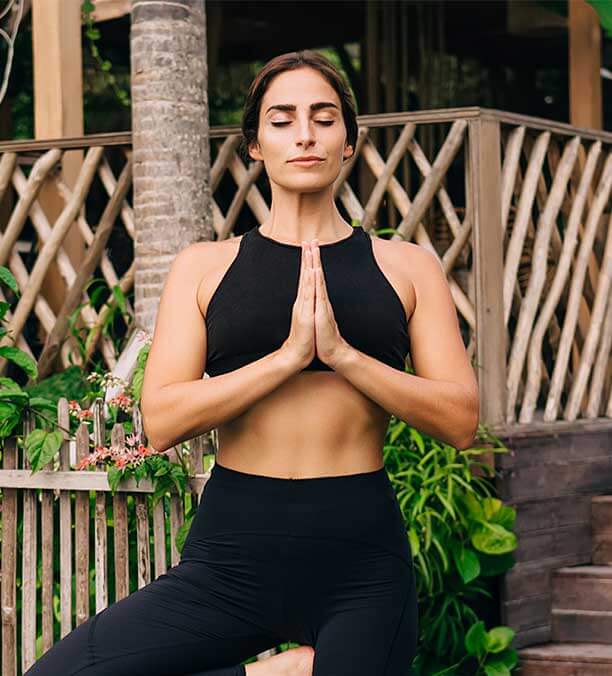Viparita Virabhadrasana
Viparita Virabhadrasana (Reverse Warrior Pose)
Description:
Viparita Virabhadrasana, also known as Reverse Warrior Pose, is a powerful yoga posture that combines strength and flexibility. It is a variation of the traditional Warrior II (Virabhadrasana II) pose, incorporating a deep side bend to enhance the stretch and challenge the body.
How to Perform Viparita Virabhadrasana:
Starting Position:
Begin in Warrior II (Virabhadrasana II) with your right foot forward.
Your right knee should be bent at a 90-degree angle, and your left leg should be straight with the foot angled slightly outward.
Transition to Reverse Warrior:
Inhale deeply.
On your exhale, lower your left hand down to rest gently on the back of your left leg.
Arm Movement:
Raise your right arm overhead, reaching towards the ceiling.
Keep your right arm straight and palm facing down or inward.
Side Bend:
As you inhale, deepen the side bend by reaching your right arm further back and arching your torso.
Gaze up towards your right hand or gently tilt your head back to look at your upper arm.
Maintain Alignment:
Keep your right knee bent and directly over your right ankle.
Ensure your hips remain open and squared to the side.
Avoid collapsing into your lower back by engaging your core muscles.
Hold the Pose:
Breathe deeply and hold the pose for 5-10 breath count, while its comfortable.
Release the Pose:
To release, inhale and return to Warrior II.
Exhale and straighten your right leg.
Repeat on the Other Side:
Transition to the other side, repeating the same steps with your left foot forward.
Benefits of Viparita Virabhadrasana:
Strengthens the Legs and Core:
Engages and tones the quadriceps, hamstrings, and glutes.
Works on the core muscles and strengthens them, increases stability and balance in the body
Stretches the Side Body:
Provides a deep stretch to the intercostal muscles, obliques, and the entire side body.
Enhances flexibility and mobility in the spine and torso.
Opens the Chest and Shoulders:
Expands the chest and shoulders, improving posture and counteracting the effects of slouching.
Enhances Focus and Concentration:
Promotes mental clarity and focus by requiring balance and coordination.
Boosts Energy and Vitality:
Invigorates the body and mind, increasing overall energy levels.
Preparatory Poses:
Warrior II (Virabhadrasana II):
Establishes the foundation and alignment necessary for Reverse Warrior.
Extended Side Angle Pose (Utthita Parsvakonasana):
Opens the hips and stretches the side body, preparing for the deeper side bend.
Triangle Pose (Trikonasana):
Improves flexibility in the hips and hamstrings, facilitating the transition to Reverse Warrior.
Counter Poses:
Child’s Pose (Balasana):
Provides a gentle stretch to the back and shoulders, allowing the body to relax.
Downward-Facing Dog (Adho Mukha Svanasana):
Stretches the entire body and releases tension in the spine.
Seated Forward Bend (Paschimottanasana):
Lengthens the spine and hamstrings, counteracting the backbend in Reverse Warrior.
Dos:
Engage Your Core:
Maintain core engagement to protect your lower back and support the pose.
Focus on Alignment:
Keep your front knee aligned over the ankle and avoid letting it collapse inward.
Breathe Deeply:
Use your breath to deepen the stretch and maintain relaxation.
Listen to Your Body:
Modify the pose if you experience any discomfort or pain.
Don’ts:
Avoid Overarching the Back:
Prevent excessive arching in the lower back by engaging your core muscles.
Don’t Lock Your Joints:
Keep a slight bend in your knees and elbows to avoid hyperextension.
Don’t Force the Stretch:
Gradually deepen the side bend without pushing beyond your comfort zone.
Avoid Dropping the Head:
Maintain a neutral neck position to avoid straining the cervical spine.
Viparita Virabhadrasana is a dynamic pose that enhances strength, flexibility, and mental focus. Incorporating this pose into your yoga practice can help you achieve a balanced and energized body and mind.




